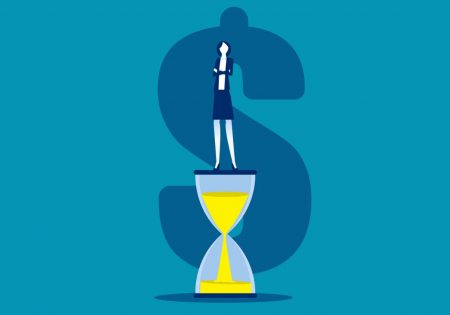As Bull Market Ages, Coaching Investors on Volatility Remains a Must
Novice investors’ reactions to stock market volatility present an endless and intriguing field of study for behavioral economists, but for financial advisers, poor client decisionmaking is a serious issue.
Over his career in the financial services industry Bob Browne, chief investment officer at Northern Trust, has often been asked about the prospect of an impending recession.
Most recently, he hears a lot of questions about the U.S. trade dispute with China, as well as more generalized concerns about the rate of global growth.
“Investors are always asking about the prospect of a recession,” he says. “What I tell them today is that, in our five-year outlook, we do foresee the potential for some slowing down of global growth. But let me be clear. Growth may moderate over the next five year period but we do not see a high likelihood of a recession.”
Browne and his team expect that, over the coming five years, growth will trend toward the structural potential of the global economy, which in their estimation is about 2%. This is not far from the published expectations of the U.S. Federal Reserve, Browne notes.
“When I am asked about the volatility that occurred in late 2018, I tend to say that it seems that the Fed made a mistake by raising rates again in the fourth quarter,” Browne says. “As you remember, the Fed was signaling at that time that they would potentially go to 3% rates in the relatively near future. That caused some broad concern among investors, but it seems the market volatility inspired the Fed to pause, which is why things have calmed down.”
Despite the escalating trade dispute between China and the U.S., Browne highlights how U.S. and global economic data has been strong. Here in the U.S., GDP growth reached 3.2% in the first quarter.
“Modest growth and low inflation, we expect, will continue to be the main themes in 2019,” Browne says. “We are, in fact, over-weight risk in the market today.”
Asked to reflect on the way investors have reacted to market volatility in the last year—many have sold equities at depressed prices to buy fixed-income investments at a premium—Browne says he commiserates with clients’ concerns. It is always scary to see the dollar value of one’s portfolio drop quickly over the course of a few days or weeks.
“But I am constantly reminding people that the best a lot of them ever felt about the markets was probably in late 2007, and the worst they ever felt was probably in March of 2009,” Browne said. “Those investors who have stayed the course during the last decade have been rewarded handsomely. The Great Recession was an extreme example, but we have to remember that, when you feel somewhat uncomfortable, that’s often the time to find the best buying opportunity for long-term investors. Long-term horizons give you a lot of flexibility and opportunity during periods of volatility.”
Sequence of Returns Risk Requires Its Own Conversation
According to Elle Switzer, director of annuity product management for CUNA Mutual Group, it is an unfortunate fact that the term “volatility,” which in itself is strictly neutral, is commonly interpreted negatively by novice investors. Making matters worse, the term is thrown around rather injudiciously by some commentators, who fail to describe both the positive and negative impacts of volatility on markets in the long-term.
“It’s one of those words that in a strict technical sense is neutral, but nonetheless it gets a bad rap,” Switzer writes in a newly published white paper on the topic, called “How Investors Can Take Control of Volatility.” “Did your car fire right up this morning? That’s because the stuff in the tank is volatile. The 401(k) account doubled over the last decade? That, too, was volatility in action.”
As Switzer explains, volatility can be good or bad, but for most people—especially casual investors such as those with a default workplace retirement plan—the connotations of volatility are entirely negative. Switzer says this is especially true when it comes to financial markets.
“The term suggests flashing red numbers, downward sloping charts, or 1929 black-and-white pictures of Wall Streeters who have lost everything,” she says.
Switzer’s theory is that the idea of volatility invokes the feeling of not being in control, which is a natural source of distress for most people, especially when it comes to money matters. While perhaps no amount of preparation can completely eliminate the anxiety that comes with market gyrations, Switzer says, a little knowledge and advanced planning can help ensure casual investors stay on course through any storms that may come their way.
According to Switzer, apart from understanding the benefits of diversification and the fact that volatility is the fundamental source of market growth in the long-term, “a little informed historical perspective” can help take the edge off volatility.
“It was big news in early 2018 when the Dow Jones Industrial Average suffered its largest one-day point loss ever,” Switzer recalls. “’Dow plunges 1,175 points in wild trading session’ was the breathless headline on CNBC. However, market veterans knew that because the market had grown so large, the February 5, 2018 selloff, in percentage terms, didn’t even register in the top 20.”
Switzer’s analysis points out that, from 1990 to 2011, the Standard & Poor’s 500 posted an average annual gain of 7.6%, while the average daily close of the VIX Volatility Index during the same period was 20.6%.
“On the other hand, in the following seven years, from 2011 to 2018, the average annual gain for the S&P 500 was 10.9%, while the daily VIX average was just 15.2%,” she writes. “With the longevity and relative calm of the current bull market, it would be understandable if investors have grown accustomed to slow steady gains and perhaps forgotten what market anxiety feels like. But they would do well to remember that the current environment is not the norm.”
Switzer emphasizes that, for the retirement audience, the most important part of this conversation is probably addressing sequence of returns risk, which in a sense is a much bigger challenge for individual investors than volatility itself.
“This is the potential risk to individual savers whose retirement windows fall at a discrete and totally random period on the timeline—sometimes when the market is marching higher—and sometimes when it is falling,” Switzer says. “While the impact of the sequence of annual returns on an investment makes no difference over time if the assets are not touched, it can have a big effect if the investor is taking distributions along the way.”
Solutions commonly floated to the sequence of returns risk issue include simply ramping down equity risk within the five years before and after the retirement date. Others point to the potential use of short term liquidity buckets, which could be invested in cash or stable value products and funded in advance during healthy markets. These funds could serve as a retirees’ primary income source during down-periods in the market, when participants want to avoid locking in their losses by making withdrawals from equity funds.
Keeping Sequence of Returns Risk in Perspective
While pretty much every investment manager working in the retirement plan space will talk about the importance of addressing sequence of returns risk, they also say this risk can be over-hyped and cause investors to be too timid.
According to an analysis published by analysts with T. Rowe Price, called “A Different Perspective on Sequence-of-Returns Risk Around Retirement,” poor returns experienced close to retirement can indeed impact the likelihood of premature exhaustion of portfolio assets. As a result, many investors understandably pay close attention to movements—particularly downward movements—in their account balances as they approach retirement.
“Some investors intuitively may gravitate toward strategies that prioritize stable portfolio balances around retirement,” the analysts write. “However, a singular focus on the impact of market movements around retirement does not capture the complete picture when it comes to factors that potentially could lead to premature exhaustion of portfolio assets. One needs to consider the full range of risks and their impact on retirement outcomes over the entire investment life cycle.”
According to the T. Rowe Price analysts, focusing solely on the potential for short‑term losses near retirement does not take into account an investor’s complete financial situation.
“Investors face other significant risks―including the risk that an overly conservative portfolio will not achieve the growth required to sustain a desired level of post-retirement income. In our view, investors are more likely to achieve their goals by balancing these different risks, both before and after retirement,” they write.
According to the T. Rowe Price analysis, conventional wisdom assumes that in the event of a large draw-down near retirement, investors with relatively conservative asset allocations will be better off because a conservative portfolio will mitigate the impact of a negative portfolio shock.
“However, this discounts the possibility that following a more growth‑oriented strategy during the accumulation phase could provide a larger portfolio balance going into retirement (i.e., the distribution phase),” the analysis states. “In other words, the benefit of having a larger accumulated balance going into retirement may outweigh the negative impact of even a large market decline close to or soon after retirement. While a more growth‑oriented portfolio might experience a relatively larger percentage loss in a market downturn, it likely still will be worth more in dollar terms, even after that decline.”
You Might Also Like:

One-Quarter of Pre-Retirees Expect to Delay Retirement, According to Nationwide

65% of Financial Advisers Braced for Recession
